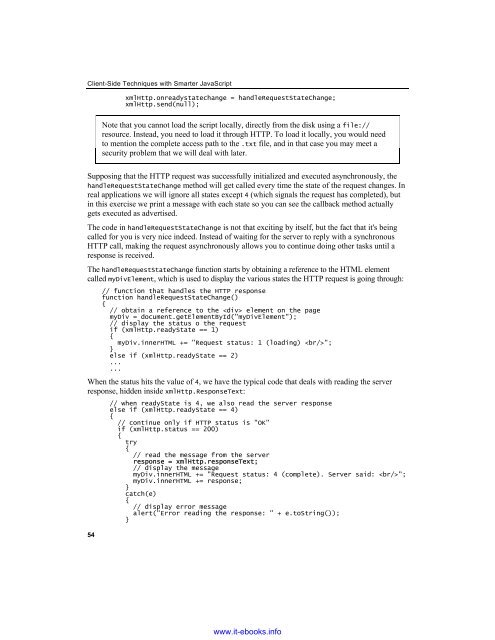AJAX and PHP
Create successful ePaper yourself
Turn your PDF publications into a flip-book with our unique Google optimized e-Paper software.
Client-Side Techniques with Smarter JavaScript<br />
xmlHttp.onreadystatechange = h<strong>and</strong>leRequestStateChange;<br />
xmlHttp.send(null);<br />
Note that you cannot load the script locally, directly from the disk using a file://<br />
resource. Instead, you need to load it through HTTP. To load it locally, you would need<br />
to mention the complete access path to the .txt file, <strong>and</strong> in that case you may meet a<br />
security problem that we will deal with later.<br />
Supposing that the HTTP request was successfully initialized <strong>and</strong> executed asynchronously, the<br />
h<strong>and</strong>leRequestStateChange method will get called every time the state of the request changes. In<br />
real applications we will ignore all states except 4 (which signals the request has completed), but<br />
in this exercise we print a message with each state so you can see the callback method actually<br />
gets executed as advertised.<br />
The code in h<strong>and</strong>leRequestStateChange is not that exciting by itself, but the fact that it's being<br />
called for you is very nice indeed. Instead of waiting for the server to reply with a synchronous<br />
HTTP call, making the request asynchronously allows you to continue doing other tasks until a<br />
response is received.<br />
The h<strong>and</strong>leRequestStateChange function starts by obtaining a reference to the HTML element<br />
called myDivElement, which is used to display the various states the HTTP request is going through:<br />
54<br />
// function that h<strong>and</strong>les the HTTP response<br />
function h<strong>and</strong>leRequestStateChange()<br />
{<br />
// obtain a reference to the element on the page<br />
myDiv = document.getElementById("myDivElement");<br />
// display the status o the request<br />
if (xmlHttp.readyState == 1)<br />
{<br />
myDiv.innerHTML += "Request status: 1 (loading) ";<br />
}<br />
else if (xmlHttp.readyState == 2)<br />
...<br />
...<br />
When the status hits the value of 4, we have the typical code that deals with reading the server<br />
response, hidden inside xmlHttp.ResponseText:<br />
// when readyState is 4, we also read the server response<br />
else if (xmlHttp.readyState == 4)<br />
{<br />
// continue only if HTTP status is "OK"<br />
if (xmlHttp.status == 200)<br />
{<br />
try<br />
{<br />
// read the message from the server<br />
response = xmlHttp.responseText;<br />
// display the message<br />
myDiv.innerHTML += "Request status: 4 (complete). Server said: ";<br />
myDiv.innerHTML += response;<br />
}<br />
catch(e)<br />
{<br />
// display error message<br />
alert("Error reading the response: " + e.toString());<br />
}<br />
www.it-ebooks.info


